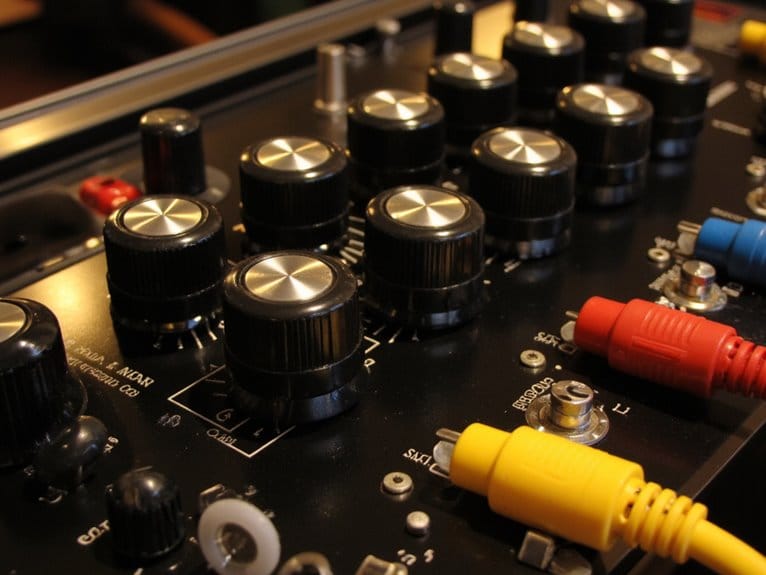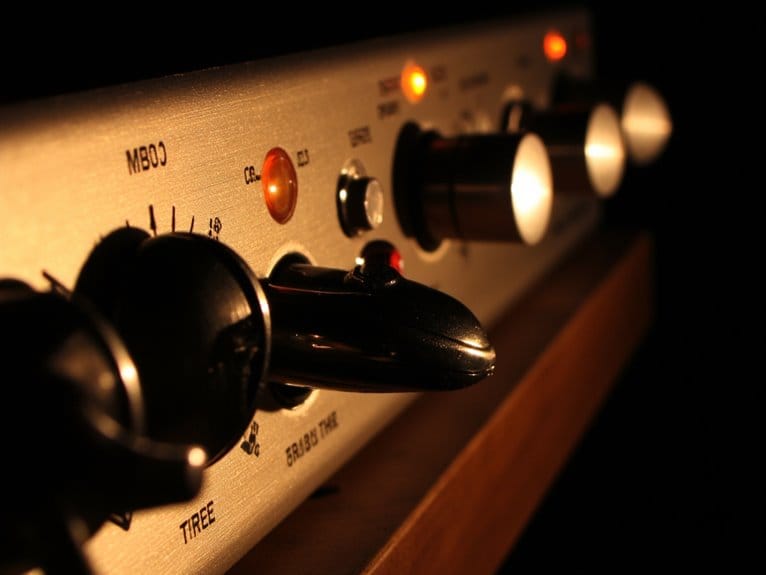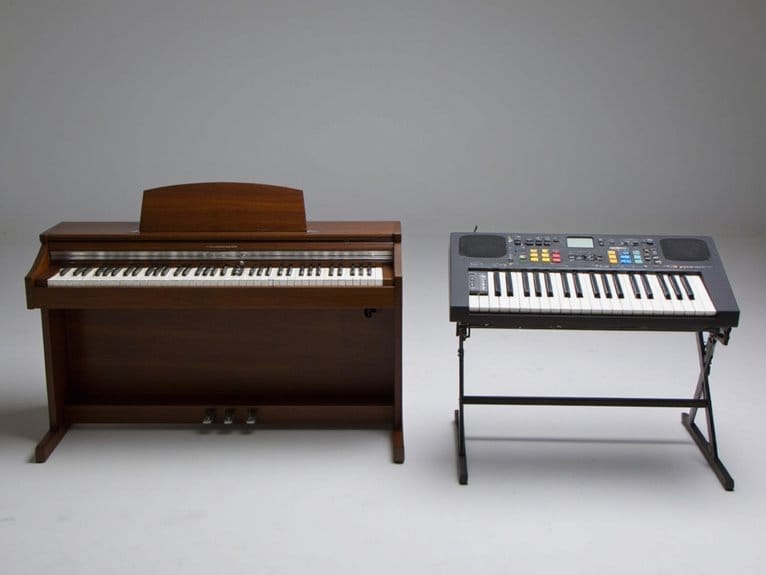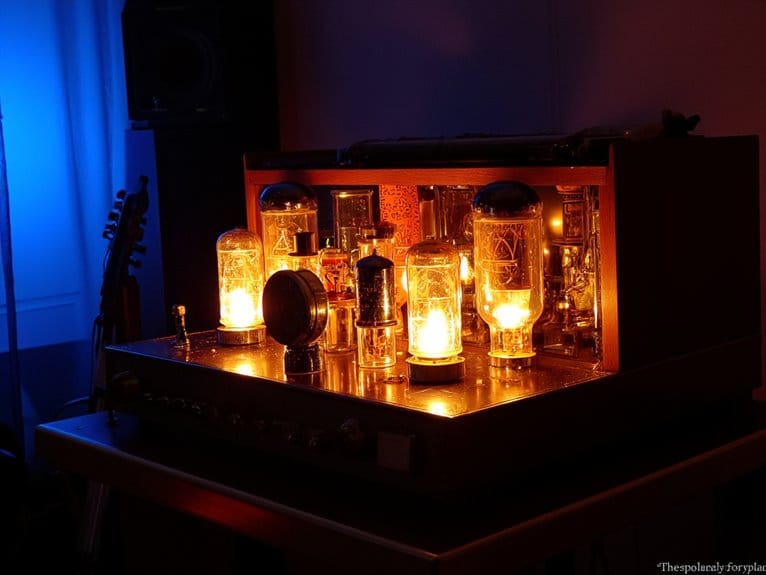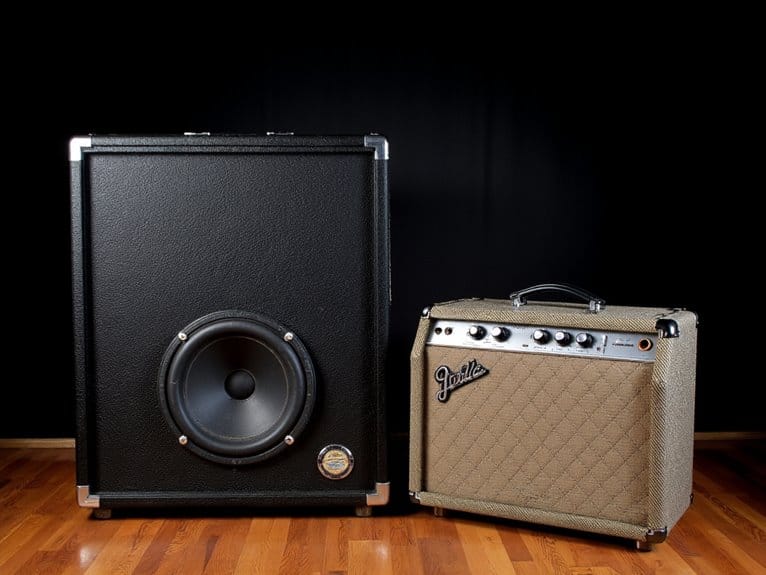Understanding Synthesizer Oscillators and Waveforms
Synthesizer oscillators generate the raw periodic waveforms that define your sound’s character, from sine waves providing clean sub-bass in hip-hop to sawtooth waves delivering aggressive leads in techno. You’ll find analog VCOs offer warmth but struggle with tuning stability, while digital oscillators provide precision and wavetable flexibility for morphing between complex timbres. Each waveform carries distinct harmonic content—square waves emphasize odd harmonics for hollow buzzy textures, while triangles offer gentle complexity with fewer overtones. Strategic layering and modulation techniques will reveal even deeper sonic possibilities.
We are supported by our audience. When you purchase through links on our site, we may earn an affiliate commission, at no extra cost for you. Learn more.
Notable Insights
- Synthesizer oscillators generate raw periodic waveforms that serve as the fundamental tonal foundation for all synthesized sounds.
- Different waveform types offer distinct harmonic content: sine waves are pure, sawtooth waves contain all harmonics, square waves emphasize odd harmonics.
- Analog VCOs provide warm, organic sounds while digital oscillators offer precise tuning stability and expanded sonic possibilities through wavetable synthesis.
- Waveform selection directly impacts genre compatibility, with sawtooth waves favoring aggressive EDM leads and sine waves providing clean sub-bass.
- Layering multiple oscillators with strategic detuning and stereo placement creates rich, complex textures while preventing frequency masking issues.
Types of Synthesizer Oscillators and Their Sound Generation Methods
At the heart of every synthesizer lies its oscillators, the fundamental sound generators that transform electrical energy into the raw waveforms we sculpt into music.
Classic analog VCOs offer distinct advantages through their warm, organic character, though you’ll face analog tuning challenges from temperature drift and component variations that require constant adjustment.
Digital precision eliminates these stability issues while expanding your sonic palette beyond traditional waveforms.
Wavetable flexibility lets you morph between complex timbres stored in memory, creating evolving textures impossible with fixed oscillators.
Sub oscillator functions thicken your sound by adding lower octaves through frequency divider applications, while specialized modulation techniques like ring modulation create entirely new harmonic content.
DCOs bridge the gap between analog and digital worlds by using microcontroller regulation to maintain stable pitch without the drift associated with pure analog circuits.
Understanding this synthesizer architecture helps you choose the right oscillator type for your musical vision. These oscillators operate across different frequency ranges that determine their functionality, from infrasonic LFO rates to audio frequencies and beyond into ultrasonic territory.
Common Oscillator Waveforms and Their Sonic Characteristics
When you’re exploring synthesizer oscillators, you’ll discover that each basic waveform type—sawtooth, square, triangle, pulse, and noise—carries its own distinct sonic personality through fundamentally different harmonic content structures.
I’ve found that understanding how these waveforms distribute their harmonic energy across the frequency spectrum, from the fundamental frequency through various overtone combinations, becomes essential for predicting and shaping the character of your synthesized sounds. The sine waveform represents the purest sound possible, containing only the fundamental frequency without any additional harmonics, making it the simplest building block for synthesis.
You’ll notice that this harmonic analysis reveals why a sawtooth wave sounds bright and aggressive compared to a triangle wave’s gentle, flute-like quality, giving you the foundation to select appropriate waveforms for specific musical applications.
Basic Waveform Types
Since oscillators form the foundation of any synthesizer, understanding the five basic waveforms they generate becomes essential for anyone looking to craft compelling sounds, whether you’re programming a vintage Moog or exploring modern digital synthesis.
These waveform soundscapes each offer distinct harmonic signatures that define your sonic palette.
Sine waves deliver pure, fundamental frequencies perfect for sub bass foundations, while triangle waves add gentle complexity through diminishing odd harmonics.
Square waves introduce that characteristic buzzy, reed-like quality with their 50% duty cycle, though pulse waves let you adjust this ratio for nasal, evolving textures.
Sawtooth waves reign supreme for aggressive leads and cutting basses, packing both even and odd harmonics into their bright, harmonically-rich spectrum. Modern synthesizers often combine these classic analog waveforms with wavetable synthesis capabilities, allowing for even more complex and evolving harmonic content.
When working with modular synths, analog VCOs provide these thick waveform sounds with the added benefit of digital tuning stability for precise frequency control.
Mastering these basic waveform applications opens up endless creative possibilities.
Harmonic Content Analysis
The mathematics behind waveform harmonic content reveals why certain oscillator shapes cut through a mix while others provide warm foundations, and I’ve found that understanding these frequency relationships transforms how you’ll approach sound design entirely.
Sawtooth waves contain the complete harmonic series with amplitudes inversely proportional to harmonic number, creating that characteristic bright, cutting tone that’s perfect for leads. Pulse waves offer variable harmonic content through duty cycle adjustments, with spectral shaping occurring dynamically as you modulate pulse width. Square waves emphasize odd harmonics exclusively, producing their distinctive hollow character.
Here’s what harmonic relationships teach us about synthesis:
- Higher harmonics decay faster, creating natural brightness-to-warmth evolution
- Nonlinear processing after amplitude control generates evolving harmonic complexity
- Duty cycle modulation enables real-time timbral transformation in pulse waves
Harmonic Content and Spectral Analysis of Waveforms
What makes one synthesizer sound bright and buzzy while another produces hollow, woody tones? The answer lies in understanding harmonic relationships and how spectral distortion shapes your instrument’s character. Each waveform’s unique harmonic structure determines its sonic fingerprint, creating the timbral differences you hear between oscillators.
| Waveform | Harmonic Content | Sonic Character |
|---|---|---|
| Sawtooth | All harmonics present | Bright, buzzy |
| Square | Odd harmonics only | Hollow, woody |
| Triangle | Weak odd harmonics | Soft, mellow |
When you’re analyzing these patterns through spectrum analyzers, you’ll notice harmonics appearing at integer multiples of your fundamental frequency. This visual representation reveals how different waveforms distribute energy across the frequency spectrum, explaining why sawtooth waves cut through dense mixes while triangle waves provide gentle, understated textures in your musical arrangements. Modern synthesizers often combine multiple synthesis methods including wavetable synthesis to create evolving timbres and dynamic textures that go beyond traditional analog waveforms. Contemporary instruments featuring three VCOs can create incredibly complex harmonic content by combining multiple oscillator frequencies and waveforms simultaneously. Advanced instruments with dual-oscillator design can layer multiple waveforms simultaneously, creating rich harmonic content that enhances the overall sonic complexity.
Practical Applications of Different Waveforms in Music Production
When you’re crafting synth patches, your waveform choice directly impacts the genre compatibility, emotional resonance, and sonic character of your track, making this decision one of the most critical starting points in sound design.
You’ll often find yourself combining multiple oscillators with different waveforms to create richer, more complex textures that evolve throughout a song, while dynamic modulation techniques like pulse width modulation and oscillator sync can transform static tones into living, breathing musical elements.
I’ve learned that understanding how each waveform behaves within specific musical contexts, from the warm sub-bass of sine waves in trap music to the aggressive bite of sawtooth leads in techno, gives you the foundation to make informed creative decisions that serve your artistic vision.
Genre-Specific Waveform Selection
Four fundamental waveforms form the backbone of modern synthesizer programming, and I’ve learned through years of production work that choosing the right one can make or break your track’s sonic identity.
Current synthesizer trends emphasize genre-specific waveform selection, while waveform innovations continue expanding creative possibilities across musical styles.
Here’s how you’ll want to approach genre-specific selection:
- EDM and electronic genres: Use sawtooth waves for aggressive leads that cut through dense mixes, creating that signature brightness and harmonic richness you need.
- Hip-hop and trap productions: Choose sine waves for clean, powerful sub-bass frequencies that hit hard without cluttering your low-end mix space.
- Retro and synthwave projects: Square waves deliver that authentic vintage aesthetic, especially when you’re recreating classic 80s synthesizer sounds.
Your genre determines your waveform foundation.
Layering Multiple Waveforms
While single waveforms provide your track’s foundation, I’ve discovered that layering multiple waveforms creates the rich, complex textures that separate professional productions from amateur attempts.
Your layering techniques should combine contrasting elements—pair smooth sine waves with aggressive sawtooths, then add subtle detuning effects of ±5 to ±10 cents for natural chorus thickness.
I’ve found that strategic stereo placement prevents frequency masking, spreading layers across the panoramic field while keeping foundational elements center-positioned.
Pitch variation through octave doubling enhances harmonic richness, particularly when you layer basslines beneath chord stacks.
Your waveform blending benefits from velocity-triggered layers that respond dynamically to playing intensity.
Smart mixing strategies involve applying different effects to each layer—reverb on pads, delays on leads—creating dynamic complexity that transforms basic oscillator combinations into professional-grade sound texture.
Dynamic Timbral Modulation
Mastery of dynamic timbral modulation transforms static waveforms into expressive, living sounds that breathe with your musical intent, and I’ve found this technique represents the difference between mechanical sequencing and genuine musical performance.
When you’re crafting dynamic soundscapes, velocity sensitivity becomes your gateway to naturally varying amplitude based on playing intensity, while aftertouch modulation grants continuous parameter control after note attack. LFOs modulate pitch, amplitude, or filter settings to create vibrato and tremolo effects that enhance your tracks with organic movement.
Here’s how I approach emotional modulation through timbre:
- Bright, piercing textures – Use high-pass filtering and rapid filter sweeps to convey excitement and tension
- Warm, mellow tones – Apply low-pass filtering with gentle envelope curves for relaxation and calmness
- Evolving atmospheres – Automate wavetable position scanning for continuously shifting, immersive environments
Waveform Manipulation and Modulation Techniques
The art of waveform manipulation transforms basic oscillator outputs into rich, evolving textures that breathe life into synthetic sounds, and I’ve found that understanding these techniques separates amateur patches from professional-quality synthesis. Wave folding techniques collapse signal peaks back into the waveform range, creating complex harmonics that define West Coast synthesis. PWM applications modulate square wave duty cycles for evolving timbres, while waveform distortion through clipping and bit crushing adds digital artifacts. Harmonic shaping via additive and subtractive methods precisely crafts frequency content.
| Technique | Parameter | Effect |
|---|---|---|
| Wave Folding | Fold Amount | Harmonic Richness |
| PWM | Duty Cycle | Evolving Timbre |
| Bit Crushing | Bit Depth | Digital Artifacts |
| Low-Pass Filter | Cutoff Frequency | Harmonic Removal |
| LFO Modulation | Rate/Depth | Movement Control |
Oscillator Functions Within Synthesizer Architecture
Beyond these sophisticated manipulation methods lies the fundamental architecture that makes such sonic sculpting possible, and I’ve learned that oscillators serve as the primary voltage generators within synthesizer signal chains, producing the raw periodic waveforms that define your instrument’s tonal foundation.
These oscillator interactions create the backbone of sound synthesis, feeding their continuous signals into voltage-controlled amplifiers that remain silent until gate signals from your keyboard trigger envelope generators.
Continuous oscillator signals flow through silent amplifiers, awaiting keyboard gates to trigger envelope generators and birth musical expression.
Here’s what makes this architecture emotionally compelling:
- Your single keypress releases cascading voltage relationships that transform mathematical waveforms into expressive musical voices
- Multiple oscillators can sync together, creating rich harmonic textures that evolve beyond simple additive combinations
- The separation between continuous tone generation and note articulation gives you complete control over musical expression
This elegant signal flow separates oscillators from amplification, enabling dynamic musical phrasing.
Frequently Asked Questions
What’s the Difference Between Hard Sync and Soft Sync in Oscillators?
Hard sync forcibly resets your follower oscillator’s phase to zero each cycle, creating harsh harmonic timbres. Soft sync uses gentler phase modifications like direction reversals, producing smoother, more chaotic textures without complete resets.
Can I Use Multiple Oscillators to Create Detuned Chorus Effects?
You can definitely create detuned layers using multiple oscillators for rich chorus effects. Slightly offset each oscillator’s pitch by a few cents, then add chorus modulation with LFOs to enhance the movement and stereo width.
Why Do Some Vintage Oscillators Sound Warmer Than Modern Digital Ones?
Vintage design creates timbre richness through analog circuit imperfections you don’t get digitally. You’re hearing subtle frequency drift, harmonic distortion, and component tolerances that add organic warmth versus mathematically perfect digital waveforms.
How Does Oscillator Drift Contribute to the Character of Analog Synthesizers?
Oscillator drift adds unpredictable pitch variations that create the beloved “living” quality in analog sound. You’ll notice subtle beating patterns and organic movement that make oscillator characteristics feel warm, three-dimensional, and authentically vintage compared to sterile digital alternatives.
On a final note
You’ve now explored the fundamental building blocks of synthesis, from basic oscillator types to complex waveform manipulation techniques. Whether you’re crafting warm pads with filtered sawtooth waves or punchy basslines using square wave sub-oscillators, understanding these core concepts will dramatically improve your sound design capabilities. Start experimenting with different waveform combinations, modulation sources, and harmonic content—your ears will quickly develop the intuition needed for effective synthesizer programming.

